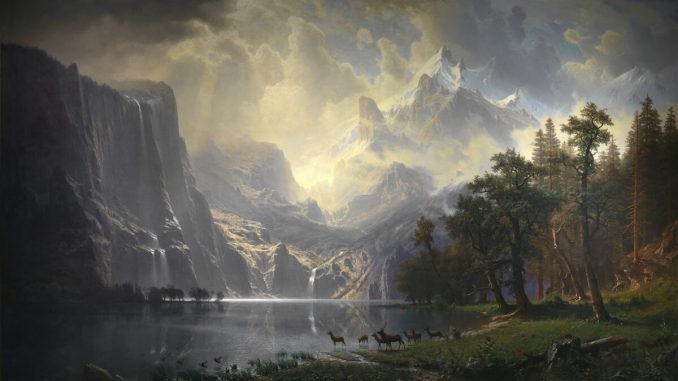

Have you ever had a painting show up at different times in your life when you needed it most?
At Penn State in 1967, in the auditorium for Professor Jim Lord’s art history survey class, a large screen spanned the width of the stage. He would flash up slides from different artistic eras—some older, then more modern pieces. Some of the abstract art with splotched canvases were forgettable.
One day he put up a painting by Albert Bierstadt. It remained on the screen longer than the others, giving 500 students a chance to drink it in. It was the most lifelike and immediately fulfilling piece of art I had ever seen. After a few more moments, Mr. Lord said that it was quite massive, so its presentation on his big screen did it justice. It made me feel something I had not known was within me. It reached into my soul and took me there, to the heart of the Sierra Nevada mountains in California.
Following the Painting
From a working-class neighborhood in Philadelphia, I had never been west of the Mississippi, and hardly west of the Susquehanna. I added a line to my life’s to-do list. Someday, I would walk the path to that lake and look up at those mountains.
In 1971, I was in training in the FBI before there was an FBI Academy at Quantico, Virginia. Classes were held in the Old Post Office in Washington, D.C. Arduous studies and masses of new information kept 30 fit and healthy trainees under the gun. On lunch breaks, my classmates strolled the nearby streets of the nation’s capital, but I had something else in mind.
The painting I so wanted to see was at the Smithsonian’s Portrait Gallery several blocks away. On our second day of classes, I found my feet beating a path to that building. I took the broad marble steps two at a time to an alcove, where on the right, were the Sierra Nevadas in all their glory.
If you have a painting that curators know is worth more than a few moments of your time, they place a bench nearby for you to sit and ponder. Over several weeks, I nearly carved out a spot there.
Midway through the last month of training, we received orders for our first office assignments. I was gleeful when mine was Los Angeles. In a month I was there, and for all of 1972, fighting crime, working undercover as a Black Panther, helping solve the second airplane hijacking—learning the trade I would ply for nearly three decades.
A good friend from my days at Villanova Law coincidentally moved to the same city. In the summer, we took a week off and drove north—the destination, his cousins in Seattle. But we would pass close enough to the Sierra Nevadas to veer off to the east. In my brand-new Datsun 240 Z, I felt I was driving to hallowed ground.
For most fine landscape artists, there is no single place to stand and paint. Rather, they will pick the best location they can find, with towering peaks, high waterfalls, lakes, denizens of the forest in tranquil terrain, and synthesize it all into a memorable image.
Steering on serpentine roads with views to valleys and vistas at higher elevations gave all the perspective needed for a beating heart to revel in. I could imagine Bierstadt standing before a glistening lake composing his magnum opus. The aromas of the forest, chirping birds, water lapping at the shoreline, a gentle breeze through the trees—and all of it melodic, like notes of music. Later, the artist would play them out as he orchestrated his visual symphony in a studio far away. He captured the power of the panorama, the nuances of nature, and the wonders of the wilderness.
The Painting Helps the FBI
From the mid-1970s through the 1980s, I was assigned to the Washington Field Office as a Cold Warrior with foreign counterintelligence expertise. On a special squad with the goal of recruiting Soviet intelligence officers, my undercover role required me to meet a Second Secretary attaché from the Soviet Embassy. This was his own undercover position, because he was actually a captain in the KGB.
A complex scam put me in his path so he would report that it was he who had found me, as opposed to his being the target of the FBI. For months I met with my new friend, Vladimir, every other Tuesday for drinks after work at Chadwicks in Old Towne Alexandria, Virginia. Gaining personal stories for personality analysis was the focus for profiling our subjects. I had formulated three questions to assess our targets: What makes him laugh? What makes him cry? And does he love his wife? The answers were crucial, and the last one was the most difficult to learn. If a Russian chose to defect, would he bring his loving wife with him to start a new life, or would defection be his excuse to leave her behind?
After a few months, it was time for me to revisit Mr. Bierstadt’s greatest achievement. But, oh no, the painting was gone! In my place of rejuvenation from grueling hours and job pressure was an empty alcove. A sign said it was on loan to another museum.
It was in Paris for three months as part of an exhibition, “A New World: Masterpieces of American Painting, 1760–1910.” But it was coming back to Washington and to the Corcoran Gallery of Art, right across from the White House.
I consulted my squadmates about my plan to invite Vlad and his wife, Galena, to the exhibition with my wife and me. We could have dinner and make an evening of it.
Naysayers around the conference table asked what could be gained. Wasn’t only Vlad the target? Who cared about his wife? Besides, they said, he would turn down the invitation. “Russians don’t do American art,” and I was “barking up the wrong tree.” My view was different.
I went to the exhibition the day it opened and learned about the pieces on display. I bought the large coffee-table book with all the color images. Studying it was my homework so I could be a docent for my Russian couple. While much of the art had been ribboned off to keep the patrons back, “Among the Sierra Nevada, California” not only had no ribbon but there was also a two-step stool right in front so visitors could get up close.
For Tuesday’s after-work drinks, I brought my highest level of enthusiasm and invited Vlad and his wife to the exhibition. I said the Soviets see too little of America with their restrictions on travel. Besides, I wanted our wives to meet.
What could he say? We set it up for the next Tuesday.
We started with dinner at Chadwicks, and then drove across the 14th Street Bridge to the Corcoran. Evenings brought a higher class of clientele, with suits and ties and well-dressed ladies. We strolled the gallery, and I told Vlad the history of several pieces. He translated for Galena. She had a halting knowledge of English, but was getting along well with my wife.
Then came the turn to the broad gallery with Albert Bierstadt’s masterpiece at the far end. We admired Asher B. Durand’s “Kindred Spirits,” and a cowboy scene by Frederic Remington. Russians, Vlad told me, had heard all about the “Wild West.” Then Galena looked down the long carpet and saw the object of my own affection.
She kept her eyes fixed on it, starting a slow walk toward it from 30 feet away. I tugged on Vlad’s sleeve and my wife followed.
Within a few feet of the painting, she stopped. She looked up to the left, then the right, and then around to all four corners. Her eyes slowly covered the full acreage of the 6-by-10-foot painting, seeming even larger in its ornate frame. Her breath was taken away.
She moved to the stool with no hesitation and took a step up. Her nose was inches from the canvas. She raised a foot to the top of the stool. Her head was abuzz with the enormity of it all.
Careful not to lose her balance on the small perch, Galena did a slow turn so her back was to the painting. She didn’t focus on the long gallery in front of her, although by now 50 people were staring at this short woman, completely captivated by a work of art.
She arched her back and lifted her chin until her eyes were looking above and behind her, upside down, at the towering mountains and radiant sky of the painting. She raised her arms from her sides, palms up, as a pastor leading his flock to sing a hymn on Sunday morning.
Vladimir was as embarrassed as a Russian diplomat could be, but his love for his wife compelled him not to interrupt her moment.
Galena spoke words that others might have thought were too audacious to proclaim out loud. Head back, arms still up, she announced: “I feel it. I want to be there. I am there!”
It was such a shocking display of genuineness. A ripple of light laughter, and then applause ran through the crowd. Everyone’s eyes were on little Galena, a woman in rapture.
The moment was over and I helped her down. A flustered Vlad, his face drained, but resigned to what had happened, said, “You must forgive my wife. Sometimes she talks outside of herself.”
He put his arms around her, as if to shield her, but also to comfort her as they slowly walked away, her eyes still glazed over.
One must understand the Soviet Union, where all large pieces of art were dedicated to “The Worker’s Paradise” and “Heroes of the Revolution,” anything to promote the Communist Party. They would have no grand display of nature to revel in. Plus, their internal controls would never have allowed Galena’s outburst, which Vlad knew well. What he didn’t know was the ultimate assessment of my intelligence target from this outing—he loved his wife dearly. With her feelings on her sleeve, and her husband’s reaction, it was more than I could hope to have learned.
Taking You There
Some 60 years after Lewis and Clark’s expedition reached the Pacific Ocean, Albert Bierstadt found himself among those wild western mountains and he was enthralled. He created a scene to capture the loveliest aspects of nature. He found just the right pieces, and with his extraordinary imagination, fit them together perfectly. The greatest impact is on the fortunate who stand right before it. With his detailed brushstrokes, he gave life to every facet of the painting.
The massive canvas could have been divided into separate, smaller paintings, each with its own story. Yet these images blend together and are overpowering: white-capped mountain peaks, descending snowfields, swirling clouds, craggy cliffs with cascading waterfalls, mist moving over a high mountain lake, droplets sprinkling down giving a glimmer to its surface, the coolness of the wind winding through the valley floor, and then a dozen ducks and deer posed serenely at the water’s edge, sheltered by centuries-old trees.
The eyes cannot move fast enough, or slowly enough, to take in the majestic slopes and scintillating sky in a single viewing. The lake’s reflection only enhances the splendor from above. Your head swivels left and right. You stand farther back and then move up close to where you can breathe in the forest air, hear its sounds, and revel in this place, declaring the timelessness and the glory and grandeur of nature.
Wayne A. Barnes was an FBI agent for 29 years working counterintelligence. He had many undercover assignments, including as a member of the Black Panthers. His first spy stories were from debriefing Soviet KGB defectors. He now investigates privately in South Florida.





Be the first to comment